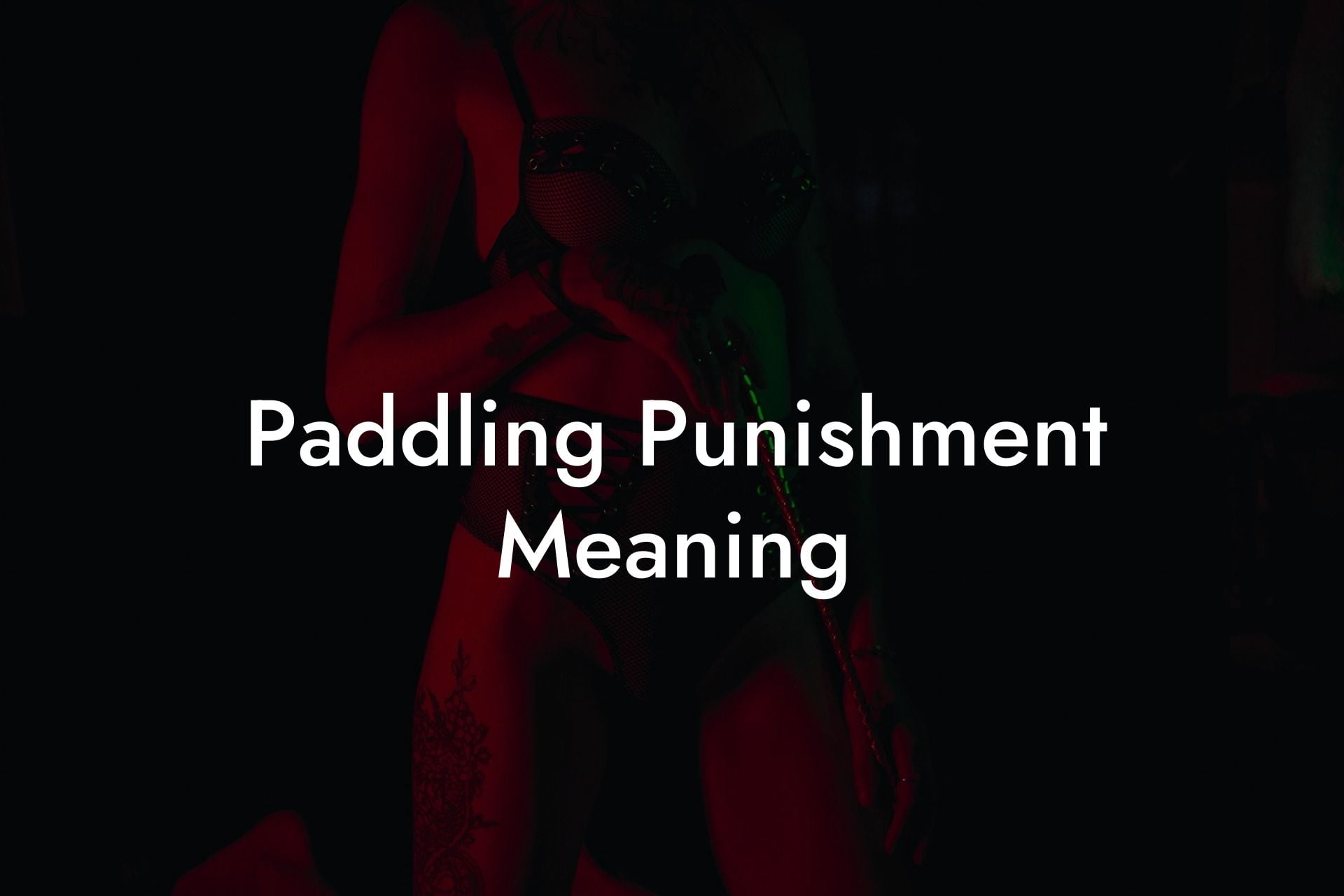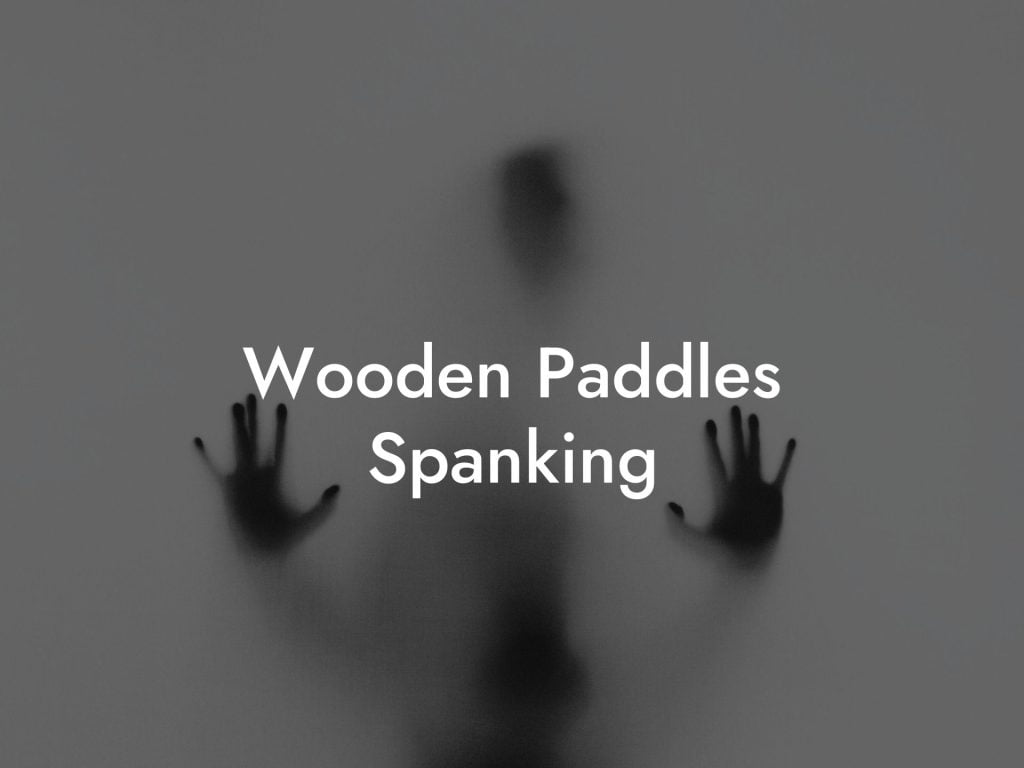Paddling punishment - a phrase that often sparks curiosity and intrigue among BDSM enthusiasts. While it may evoke images of intense pain and domination, there is much more to this practice than meets the eye. In this comprehensive guide, we will delve into the meaning behind paddling punishment and shed light on its psychological aspects, techniques, and motivations. Whether you're a seasoned player or just beginning your exploration into the world of kink, this article will provide valuable insights into the captivating realm of paddling punishment.
Paddling Punishment Meaning Table of Contents
Paddling punishment, also known as spanking or caning, involves the consensual act of striking a person's buttocks, thighs, or other erogenous zones with a paddle or similar tool. It is a form of impact play, which encompasses a wide range of activities within the BDSM spectrum. While it is commonly perceived as a disciplinary act, paddling punishment can also be purely erotic, aimed at heightening arousal and exploring power dynamics between partners.
The motivations behind engaging in paddling punishment are diverse and deeply personal. For some, it is a way to fulfill a submissive or masochistic desire, experiencing the pleasure that arises from pain. Others may find it cathartic, using this form of punishment as a means of release and stress relief. The anticipation, fear, and vulnerability associated with receiving a paddling further enhance the intensity and emotional connection between partners.
When it comes to techniques, there are various ways to administer paddling punishment. The choice of paddle material, shape, and size can significantly influence the sensation and outcome. Some prefer leather paddles for a thuddy sensation, while others opt for wooden paddles for a sharper sting. The intensity of the strikes can be regulated through the force of impact, the angle at which the strikes are delivered, and the targeted areas of the body. Communication and consent between partners are crucial to ensure the experience remains safe, consensual, and within pre-established limits.
Frequently Asked Questions
What is BDSM?
BDSM stands for Bondage and Discipline, Dominance and Submission, Sadism and Masochism. It is a broad range of activities, behaviors, and power dynamics that consenting adults use to explore their sexuality, comfort levels, and personal boundaries. BDSM can include physical restraint, sensory deprivation, erotic spanking, and a variety of other practices.
Looking for the best BDSM & Kink OnlyFans content creators? Here is a list of of our favourites that you will love:
-
- Best BDSM & Fetish OnlyFans - Molly✨ >> Link
- Best BBW & Huge Ass OnlyFans - Naughty Hanna Zimmer 💜🎀 >> Link
- Best Sexy Gaming Nerd OnlyFans - 🎮 Gracy EstuSWEET 🎮 >> Link
- Best Fetish & Kink Messaging OnlyFans - 💫Lola La Fleur 💫 >> Link
- Best Girl Next Door OnlyFans - ☀️Lily ⛅ >> Link
- Best Tiny European OnlyFans - 💝 Ami Allison 💝 >> Link
- Best Cosplay OnlyFans - 🐱 Little Kitty Kate 👉👌 >> Link
- Best Little OnlyFans - 🧸 Katya 🙇♀️ Sun >> Link
- Best Sub OnlyFans - 🍌Hanna Banana🍌 >> Link
- Best Teen & Huge Tits OnlyFans - ❣️Anny❣️19 y.o. BUSTY student girl >> Link
- Best Tiny Tits OnlyFans - ⍣⭐️ Sofia Parker ⭐️⍣ >> Link
- Best Sub & Huge Boobs OnlyFans - Nika Huge Boobs >> Link
- Best Kink OnlyFans - Julia Pearl🐚 >> Link
- Best Fetish & Girl Next Door OnlyFans - Hillary is Wet 💦 >> Link
- Best Dirty Latina OnlyFans - Paula Flores 😈 >> Link
Not quite what you are looking for? View the full list →
What does impact play involve?
Impact play refers to the BDSM practice where one person is struck by another for the gratification of either or both parties. Common implements used in impact play include hands, floggers, paddles, whips, or canes. The intensity and areas of impact vary according to the preferences and agreements of the participants.
How do I choose the right flogger for impact play?
Choosing a flogger depends on a variety of factors including your level of experience, the sensation you desire, and the area of the body you wish to target. Floggers can vary in materials, lengths, weights, and the number of tails. Starting with a soft, lightweight flogger made from materials like suede or soft leather is recommended for beginners.
What is the proper way to use a paddle in BDSM?
A paddle is used in BDSM for spanking and should be used with care. Good technique involves understanding the correct positioning, striking with the flat part of the paddle, and communication with your partner. It's important to aim for fleshy, muscled areas like the buttocks and to avoid bony or delicate parts of the body.
Can you explain BDSM power dynamics?
BDSM power dynamics involve a consensual exchange of power between individuals. These roles can include Dominant/submissive, Master/slave, or Top/bottom, among others. The extent and nature of the power exchange are negotiated and agreed upon beforehand by all parties involved.
Why is consent vital in BDSM?
Consent is the cornerstone of all BDSM interactions; without it, an act is considered abuse. Consent must be informed, enthusiastic, and given freely without any form of coercion. It involves clear communication and understanding the intentions, limits, and boundaries of everyone involved.
How do you negotiate a BDSM scene?
Negotiating a BDSM scene involves discussing and agreeing upon the activities that will be part of the scene, the roles of each person, the limits and boundaries, safe words or signals, and any aftercare needs. It is essential to be honest, open, and specific during negotiations to ensure the safety and enjoyment of the parties involved.
What is a safeword, and why is it important?
A safeword is a pre-agreed word or signal used during BDSM play that signifies the need to pause, check-in, or stop the scene. It is a critical tool for communication and ensuring the safety and consensuality of the act. Choosing a safeword that is easy to remember and unlikely to be confused with roleplay is important.
How does trust play a role in BDSM relationships?
Trust is fundamental in BDSM relationships as they often involve a high level of vulnerability and power exchange. Building trust takes time and involves consistently respecting boundaries, maintaining open communication, and honoring the negotiated terms of encounters. Without trust, the dynamic can become unsafe and unfulfilling.
What should be included in a BDSM safety plan?
A BDSM safety plan should include the use of safewords or gestures, knowledge of the participant's physical and psychological limits, preparation of necessary safety equipment (such as scissors or keys for quick release), and a plan for aftercare following the scene. Knowledge of first aid and consent laws are also crucial.
What is aftercare in BDSM?
Aftercare refers to the time spent following a BDSM scene where participants check in with each other, provide emotional support, and take care of any physical needs. This can include hydrating, warming up with blankets, treating any mild injuries, talking through the scene, or simply enjoying quiet time together.
How do I introduce BDSM into my relationship?
Introducing BDSM into a relationship should be done gradually with open and honest conversation. Share your interests and desires with your partner, research together, and start slow, possibly with lighter activities like blindfolding or light restraint before progressing to more advanced practices.
Are there any risks associated with BDSM?
Yes, like any sexual activity, BDSM carries both physical and emotional risks. These can include accidental injury, miscommunication, emotional distress, or unintended psychological effects. Mitigating these risks through education, communication, consent, and safe practices is essential.
Is it normal to have mixed feelings after a BDSM session?
Yes, it's entirely normal to experience a range of emotions after a BDSM session. Feelings can run from elation and closeness to confusion or sadness, sometimes referred to as "sub-drop" or "top-drop" when subspace or topspace wears off. Aftercare and open communication can help navigate these feelings.
How do I find a BDSM community?
Finding a BDSM community can be done by researching online for local groups, attending events or workshops, or through social media and forums that cater to the BDSM lifestyle. Always be cautious and respectful when joining these communities, and remember to protect your privacy.
Can BDSM practices be therapeutic?
While BDSM is not a substitute for professional therapy, many find certain aspects of BDSM, such as the power dynamics, rituals, and sensation play, to have therapeutic effects, offering a release from stress, the creation of a safe space to explore vulnerabilities, and the strengthening of the bonds between partners.
How do I know if BDSM is right for me?
Understanding if BDSM is right for you involves self-exploration and reflection on your desires and boundaries. Starting with light activities and education can help you understand your comfort level and interests. Communication with a partner or members of the BDSM community can also provide insight.
What are the legal considerations surrounding BDSM?
BDSM practices can be subject to legal considerations depending on the jurisdiction. Activities must always involve consenting adults and adhere to the local laws governing assault, sexual conduct, and private behavior. Always stay informed and respect the legal boundaries in your area.
Can I practice BDSM without a partner?
Yes, you can explore aspects of BDSM alone through self-tying, self-spanking, or sensory play, for example. Solo practice can be a safe way to explore your limits and preferences, which can later enhance experiences with a partner.
What should I do if something goes wrong during a BDSM scene?
If something goes wrong, use your safeword or signal immediately to stop the play. Attend to any injuries, provide comfort as needed, and openly discuss what happened, why it went wrong, and how to prevent similar issues in the future. Learning from the experience is important for practice and relationship growth.
As we conclude this exploration into the fascinating world of paddling punishment, we invite you to continue your journey by exploring the vast array of resources at Filthy Adult. Order your own artisan-made to order WeSpank spank paddle, read our other informative guides on BDSM practices, and browse our fetish shop, where you'll find an exquisite collection of high-quality products tailored to your desires. Don't hesitate to share this article and spread the knowledge, as we believe that informed exploration leads to unforgettable experiences in the realm of kink.













